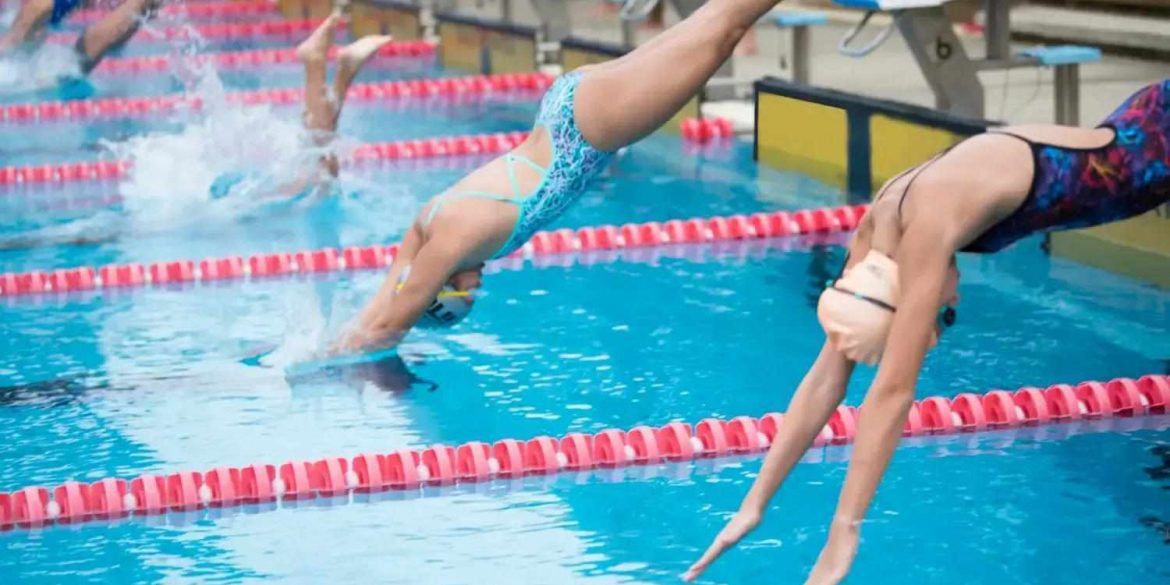The six main swimming strokes are Freestyle (Front Crawl), Backstroke, Breaststroke, Butterfly, Sidestroke, and Dog Paddle. Each stroke offers unique techniques, speed characteristics, and benefits—from Olympic competition to life-saving scenarios.
Whether you’re a beginner learning your first swimming technique or an experienced swimmer exploring new methods, understanding different swimming strokes names and their applications transforms your aquatic experience.
Quick Reference: Swimming Strokes Comparison
| Stroke Name | Also Known As | Speed | Difficulty | Best For | Calories/30min* |
|---|---|---|---|---|---|
| Freestyle | Front Crawl, Australian Crawl | ⭐⭐⭐⭐⭐ Fastest | Medium | Competition, Distance | ~300 cal |
| Butterfly | Fly, Dolphin Stroke | ⭐⭐⭐⭐ Very Fast | Very Hard | Power, Short Distance | ~330 cal |
| Backstroke | Back Crawl | ⭐⭐⭐⭐ Fast | Easy-Medium | Easy Breathing, Back Health | ~240 cal |
| Breaststroke | Frog Style | ⭐⭐ Slow | Medium | Endurance, Recreation | ~200 cal |
| Sidestroke | — | ⭐⭐⭐ Medium | Easy | Survival, Lifesaving | ~180 cal |
| Dog Paddle | — | ⭐ Slowest | Very Easy | Beginners, Confidence | ~150 cal |
Based on 155-pound person
The 4 Competitive Swimming Strokes
These four swimming strokes form the foundation of Olympic swimming and competitive aquatics worldwide. Understanding these techniques helps swimmers choose the right approach for training and competition.
1. Freestyle Stroke (Front Crawl): Fastest Swimming Technique
Freestyle is the fastest and most efficient swimming stroke for most distances. This technique combines alternating arm movements with a consistent flutter kick and rhythmic side breathing.
Key Technique Points:
- Body Position: Streamlined, horizontal, face-down
- Arm Movement: Alternating windmill motion with high elbow catch
- Kick: Continuous flutter kick from hips
- Breathing: Turn head to side every 2-3 strokes
Why It’s Popular: Elite swimmers achieve speeds exceeding 5 mph using freestyle. The stroke maintains constant forward momentum without built-in gliding phases, making it ideal for both sprint and distance events.
Best For: Competition, distance swimming, triathlon events, cardiovascular fitness
2. Backstroke: Easy Breathing Technique
Backstroke offers unique advantages with easy breathing while maintaining competitive speed. Swimmers lie on their backs using alternating arm movements similar to freestyle but in reverse, combined with a flutter kick.
Key Technique Points:
- Body Position: On back, horizontal, face up
- Arm Movement: Alternating windmill motion, recovering over water
- Kick: Flutter kick with pointed toes
- Breathing: Unrestricted—face stays above water
Why It’s Popular: Doctors often recommend backstroke for individuals with back problems as it provides excellent therapeutic benefits and core strengthening.
Best For: Beginners learning breathing control, back rehabilitation, recreational swimming
3. Breaststroke: Power and Precision
Breaststroke represents the oldest competitive swimming stroke. The simultaneous arm movement followed by a powerful frog kick creates a distinctive undulating motion. While slower than other competitive strokes, breaststroke offers superior power development.
Key Technique Points:
- Body Position: Horizontal, face-down, undulating motion
- Arm Movement: Simultaneous half-circular sweep
- Kick: Whip kick (frog kick) with knees bent
- Breathing: Lift head forward during arm pull
Why It’s Popular: Most commonly taught stroke for beginners because you don’t need to put your face underwater constantly. Excellent for building upper body strength.
Best For: Endurance training, recreational swimming, beginners, fitness workouts
4. Butterfly Stroke: Advanced Challenge
Butterfly demands the highest level of strength, coordination, and technique among all competitive swimming strokes. The simultaneous arm movement combined with dolphin kick creates spectacular forward propulsion but requires significant energy.
Key Technique Points:
- Body Position: Undulating wave-like motion from head to toes
- Arm Movement: Simultaneous overhead sweep, both arms together
- Kick: Dolphin kick—both legs together, two kicks per stroke cycle
- Breathing: Lift head forward during arm recovery
Why It’s Challenging: Most physically demanding stroke, requiring exceptional core strength and coordination. However, it provides unparalleled upper body development.
Best For: Advanced swimmers, competitive training, building power and core strength
Additional Swimming Strokes: Recreation & Survival
Beyond competitive swimming styles, these additional techniques serve important recreational and safety purposes.
5. Sidestroke: Survival & Endurance
Sidestroke excels in energy conservation, making it ideal for long-distance swimming and rescue situations. Swimming on one side with a scissor kick and alternating arm movements allows easy breathing and minimal fatigue.
Key Features:
- Can be maintained for hours with minimal energy
- Used by lifeguards during rescue operations
- Excellent for rough water conditions
- Allows towing another person while swimming
Best For: Lifesaving, survival swimming, long-distance endurance
6. Dog Paddle: Beginner-Friendly
Dog Paddle represents humanity’s most instinctive swimming movement, mimicking how animals naturally move through water. This simple technique keeps the head above water while using basic arm and leg movements.
Key Features:
- Easiest stroke to learn—no formal instruction needed
- Head stays above water (reduces anxiety)
- Immediate mobility for non-swimmers
- Excellent confidence builder
Best For: Complete beginners, young children, building water confidence
Swimming Strokes for Different Goals
For Speed & Competition
Focus on: Freestyle, Butterfly, Backstroke, Breaststroke
Competitive swimmers should master all four Olympic strokes. Freestyle offers the highest speed potential (world record: 20.91 seconds for 50m), while other strokes provide variety and competitive opportunities in individual events and medley races.
For Fitness & Exercise
Recommended Mix:
- Freestyle for cardiovascular endurance (300 cal/30 min)
- Backstroke for core strength and posture improvement
- Breaststroke for upper body power development
- Butterfly for intensive calorie burn (330 cal/30 min)
Varying swimming styles prevents overuse injuries and ensures balanced muscle development while keeping workouts engaging.
For Beginners & Water Safety
Start With: Dog Paddle → Elementary Backstroke → Breaststroke → Freestyle
New swimmers should begin with techniques that allow comfortable breathing while learning basic water movement. Progress gradually from simple strokes to more complex techniques as confidence builds.
Swimming Strokes Ranked by Calorie Burn
Based on 30 minutes of swimming for a 155-pound person:
- Butterfly: ~330 calories (highest burn)
- Freestyle: ~300 calories
- Backstroke: ~240 calories
- Breaststroke: ~200 calories
- Sidestroke: ~180 calories
- Dog Paddle: ~150 calories
Note: Actual calorie burn varies based on intensity, body weight, technique efficiency, and fitness level.
Benefits of Learning Multiple Swimming Strokes
Complete Physical Development
Different swimming styles work distinct muscle groups:
- Freestyle: Shoulders, core, cardiovascular endurance
- Backstroke: Posterior chain, glutes, back muscles
- Breaststroke: Chest, inner thighs, upper body power
- Butterfly: Full-body engagement, core conditioning
Enhanced Water Safety
Swimmers comfortable with multiple techniques can adapt to various water conditions and emergency situations. If fatigue sets in during one stroke, switching to a more energy-efficient technique can prevent dangerous situations.
Injury Prevention
Cross-training with different swimming strokes prevents overuse injuries common among single-stroke swimmers. Style diversity distributes physical stress across different muscle groups and movement patterns.
Olympic Swimming Strokes: Competition Standards
The four competitive swimming strokes names are standardized worldwide by World Aquatics (formerly FINA):
Stroke Order in Medley:
- Individual Medley: Butterfly → Backstroke → Breaststroke → Freestyle
- Medley Relay: Backstroke → Breaststroke → Butterfly → Freestyle
Olympic Distances:
- Freestyle: 50m, 100m, 200m, 400m, 800m (women), 1500m (men)
- Backstroke: 100m, 200m
- Breaststroke: 100m, 200m
- Butterfly: 100m, 200m
- Individual Medley: 200m, 400m
Learning Strategy: Progressive Development
Foundation Phase (Weeks 1-4)
Focus: Water comfort, breathing control, floating
Start With:
- Dog paddle for confidence
- Elementary backstroke for breathing practice
- Basic water safety skills
Development Phase (Weeks 5-12)
Focus: Technique and efficiency
Progress To:
- Freestyle with proper breathing rhythm
- Backstroke with coordinated arm movements
- Breaststroke with timing practice
Advanced Phase (3+ Months)
Focus: Refinement and specialization
Master:
- Butterfly technique and dolphin kick
- Competitive turns and starts
- Speed and endurance training
FAQ
What are the 6 main types of swimming?
The 6 main swimming strokes are: Freestyle (Front Crawl), Backstroke, Breaststroke, Butterfly, Sidestroke, and Dog Paddle. The first four are competitive Olympic strokes, while Sidestroke and Dog Paddle serve recreational and survival purposes.
Which is the fastest swimming stroke?
Freestyle (front crawl) is the fastest swimming stroke. Elite swimmers achieve speeds exceeding 5 mph, with the world record for 50m freestyle at 20.91 seconds (César Cielo, 2009).
What swimming stroke is best for beginners?
Dog Paddle and Elementary Backstroke are best for beginners. These strokes keep the head above water, require minimal coordination, and build water confidence without overwhelming technical demands.
What are the 4 competitive swimming strokes names?
The 4 competitive swimming strokes used in Olympic competition are: Freestyle (Front Crawl), Backstroke, Breaststroke, and Butterfly. These standardized strokes form the foundation of competitive swimming worldwide.
Which swimming stroke burns the most calories?
Butterfly stroke burns the most calories—approximately 330 calories per 30 minutes due to its demanding full-body movement. However, freestyle provides the best sustainable calorie burn for longer workouts at ~300 calories per 30 minutes.
What’s the difference between swimming styles and swimming strokes?
In modern swimming terminology, “swimming styles” and “swimming strokes” are used interchangeably to describe different techniques of moving through water. Both terms refer to the complete body techniques including arm movements, kicks, breathing, and body positioning.
How many swimming strokes are there in total?
There are dozens of different swimming techniques when including competitive, recreational, survival, and cultural methods. Beyond the 4 Olympic strokes, swimmers can learn survival strokes, traditional techniques, and modified variations—totaling over 20 distinct styles.
Which swimming strokes are used for survival situations?
Survival swimming strokes include Sidestroke (most energy-efficient), Survival Backstroke (emergency floating), and Elementary Backstroke. These techniques prioritize energy conservation over speed, allowing swimmers to stay afloat for extended periods.
Conclusion
Mastering different swimming strokes names and techniques opens up a world of aquatic possibilities—from competitive excellence to life-saving skills. The six main types of swimming offer options for every skill level and goal:
- Competitive swimmers benefit from perfecting all four Olympic strokes
- Fitness enthusiasts gain from mixing multiple techniques for balanced development
- Beginners build confidence starting with simple strokes before progressing
- Safety-conscious swimmers learn survival techniques for emergency preparedness
Your swimming journey is unique to your goals and abilities. Start with techniques that match your current skill level, then progressively challenge yourself with more advanced swimming styles. Remember: becoming proficient requires patience and consistent practice, but the investment in learning diverse swimming techniques pays dividends in safety, fitness, and lifelong aquatic enjoyment.
Ready to start? Choose the swimming stroke that matches your goals and dive in—the water’s waiting!

